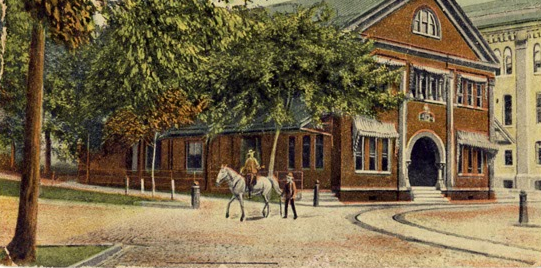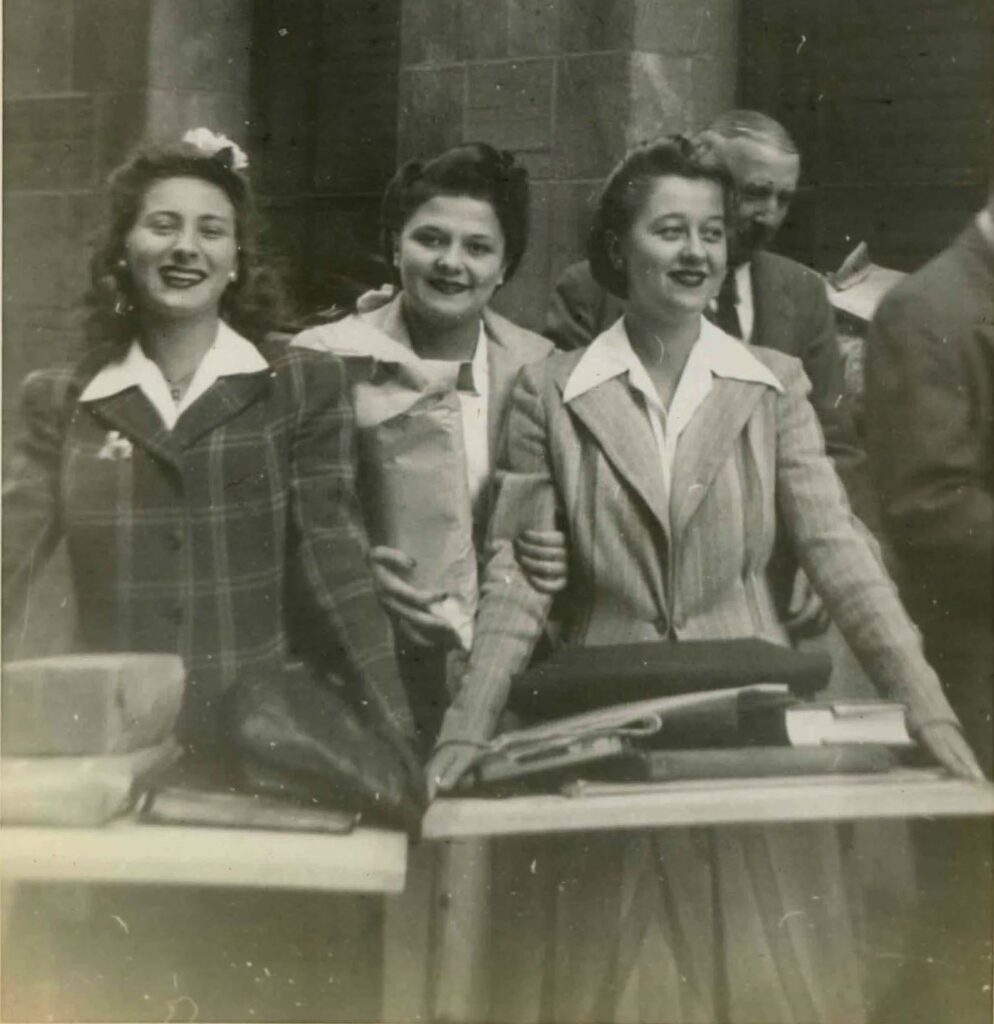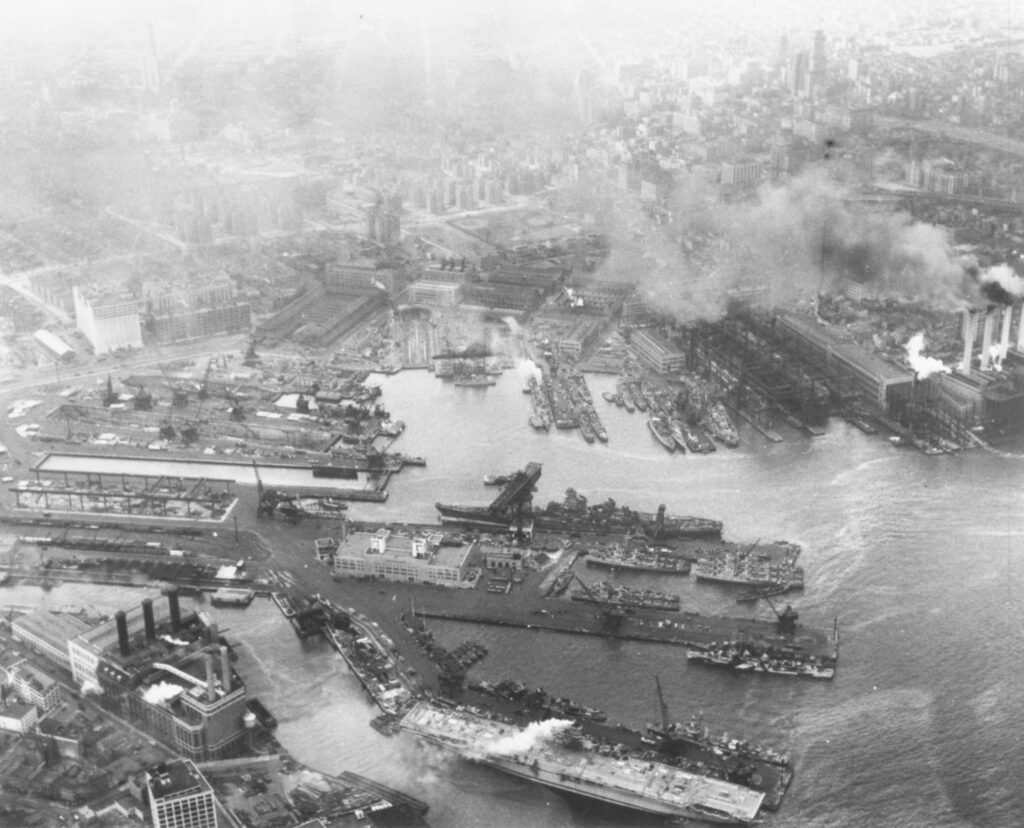BNYDC Archives' Collection Guides
These are some resources that are relevant to general inquiries about the history of the Yard:
Below are guides to collections maintained by the BNYDC Archives. A collection guide offers both the context and the contents of a collection.
Antoinette Mauro was recruited as a draftswoman as part of the war effort. Photographs and personal effects of Antoinette Mauro and her husband, Louis, during their employment at the New York Naval Shipyard, including photographs taken at the launching of USS Oriskany.
Photographs of Clarence Irving, a machinist at the Brooklyn Navy Yard.
Photographs of Jack Brock and fellow sailors on the USS Missouri when it was docked in the Brooklyn Navy Yard, after returning from the Pacific in the fall of 1945.
Herbert Fahr was on the crew of the USS Missouri during the Korean War tour. He was born and raised in Brooklyn, and his father (Herbert Fahr, Sr.) owned a bakery located near the Brooklyn Navy Yard that sailors and other Navy Yard personnel would frequent. Collection includes a launching of the USS Missouri envelope and 2 photographs of Herbert Fahr’s father’s bakery (located near the Navy Yard).
David Davies was a boilermaker at the Brooklyn Navy Yard. The collection includes 2 plaques, a boilermaker identification card, a vaccination card, and a letter of recommendation.
Nancy Bowen is an artist who maintains a studio in the Brooklyn Navy Yard. This collection contains an 1898 letter on USS Massachusetts letterhead, as well as some of her works of art.
Employment files of carpenter George Gittleson, who was a member of the United Bortherhood of Carpenters and Joiners of America and who worked at the Yard for over 20 years.
Edward T. Steiniger, born April 30, 1942, was a member of the United States Marine Corps who, as a Lance Corporal, was stationed at the Brooklyn Navy Yard circa 1962-1964. This collection includes photographs and ephemera.
Ambrose Merrill was employed in the Drafting Department at the New York Naval Shipyard from 1905 – 1949. He became Chief Draftsman in 1929, and in 1938 he was promoted to Head Engineer of the Hull-Design Division. This collection contains his professional and personal effects.
The Hoyer brothers, John H. (1845-1914) and Frederick (1854-1906), were born in Germany and worked in the New York Naval Shipyard around the turn of the 20th century. One of the brothers was awarded for service on the USS Indiana (BB-1). Frederick was killed in an accident at the Navy Yard in 1906, after which his widowed wife, Albertine, married his older brother, John, who worked in the Navy Yard payroll department. Some items document the marriages of Albertine and the Hoyer brothers, while others are photographs of, or items given to, John when he retired. Other documents relate to a descendant of Frederick Hoyer, Walter J. Kinkel (1920-2010), who was in the camouflage unit of the 23rd Headquarters Special Troops during the Second World War. These documents were arranged into 14 “exhibits” by the donor.
Joseph Sackowitz was born on April 8, 1911. He was employed at the Brooklyn Navy Yard from 1941 – 1945 and helped build the USS Missouri. Collection includes his personal effects.
Leo Markowitz began working at the New York Naval Shipyard in 1932 as an apprentice machinist, eventually moving into an administrative position in 1946 where he remained (with changing titles) until the Navy Yard was closed in 1966. He dedicated a portion of his salary to victory bonds while he worked at the Navy Yard during the Second World War, and corresponded with a fellow employee who served in the European theater. He also attended many training programs, participated in the construction of the USS Constellation (CV-64), and visited factories and naval yards across the nation.
Abraham Friedman was a rigger’s helper and rigger man at the New York Naval Shipyard from 1918 to 1954. Employment forms and correspondence document Friedman’s various positions and personal events involved with the Navy Yard. Ephemera includes photographic identification, Employees Safety Club and union cards that range from 1942 to 1954.
Identification cards for a former Yard employee in the CLICK era, after the US Navy decommissioned the site.
Jacobe Adelman was in the US Coast Guard and worked at the Yard. Collection contains his USCG identification card.
John J. Holford Sr. was born on October 19, 1911 and worked at the New York Naval Yard as a heavy trailer truck driver from around 1941 until 1966. Holford’s identification badge, issued in 1960, is included with a notification of reduction in force from the Commander. The reduction in force was a result of the the Navy Yard’s planned closure in June 1966.
Discharge papers from the United States Navy, pension information, as well as information from the Veterans Administration regarding burial procedures for Clarence Lyons.
John Oropallo started as an apprentice at the New York Naval Shipyard where he worked from 1946 until 1964. Material used by Oropallo during his employment comprise the collection, in particular manuals and data sheets for sheetmetal.
Julia Uvick worked at the Brooklyn Navy Yard from 1940 to 1953, when she resigned to have children. Julia worked in a variety of capacities within the Navy Yard’s accounting department. She met Richard Uvick in 1948 in the Fiscal Accounting Department; they became engaged in May of that same year and were married one month later. The personal effects and professional documents of the period make up the collection.
This collection consists of material related to Anna Mark-Goodman’s employment at the Brooklyn Navy Yard during World War II and the post-war period.
Louis Kaplan’s personnel record documenting his employment at the New York Naval Shipyard, as well as miscellaneous items related to his service.
The materials in this collection were compiled as part of the research interests of Frank Trezza, who worked for Seatrain Shipbuilding Corporation from 1973-1979. The collection consists primarily of copies of articles and web resources pertaining to the period Seatrain operated at the Brooklyn Navy Yard and its subsequent failure and closure. There is some material on the U.S. Navy operations at the Yard. Other materials include abstracts, correspondence, court proceedings, journals, oral history transcripts, reports, tax documentation, digital photographs, and video material surrounding activities at the Brooklyn Navy Yard and Seatrain itself. A copy of Frank Trezza’s autobiography, Brooklyn Steel-Blood Tenacity, and a related appendix is also included in this collection.
Personal effects of Virginia Ferdon during her employment at the New York Naval Shipyard.
Sidonia “Sid” Levine was one of the first female ship workers hired at the Brooklyn Navy Yard during World War II. She worked at the Yard from 1942 to 1945 as a blueprint reader and drafter in the mold loft where she interpreted the blueprints into patterns. The collection consists of digital reproductions of original template drafts created by Levine, a diploma for a ship drafting course, a Navy Yard patch, and personal effects.
Service papers for Monroe D. Gluck, including a recognition of service for his time at the Yard.
During the 1970s, Susan Detrich created advertising and graphic arts materials for Seatrain Shipbuilding which operated at the Brooklyn Navy Yard under the Commerce Labor Industry Corporation of Kings (CLICK) from 1967 to 1979. The materials in this collection include paper and digital items created and/or collected by Susan Detrich from that era.
Wesley Fagan was a photographer and musician. He began his career at the Brooklyn Navy Yard as a messenger, working his way up to Supervisor of the Photographic Division in Building 77. This collection contains photographs from his time in the US Army, his work at the Yard, and his personal life.
Forrest Tomlinson was a member of the Board of Directors of Commerce Labor Industry County Kings (CLICK), the first non-profit organization to manage the Brooklyn Navy Yard after its decommissioning. The collection includes photographs from the launching of the Tanker Brooklyn, built by Seatrain Shipbuilding, a CLICK tenant.
Arthur “Rocky” Ianaconne was a mechanic at the Yard, working is way up from apprentice to foreman. This collection includes his personal effects.
Ernest Frey left school at age 16 and started his tenure at the New York Naval Shipyard as an apprenticed electrician. He became an electrician in 1924 and continued working his way to Master Mechanic Ordnance by 1946. He retired from the Brooklyn Navy Yard in August of 1961. Collection contains Ernest Frey’s professional papers and effects during his employment at the Yard
Luigi (Lou) Fumo was an apprentice and then a machinist at the Brooklyn Navy Yard during the 1950s and 1960s. The collection includes an oral history, tools, photographs, jewelry, personal papers, and memorabilia relating to ship launchings at the Navy Yard.
Harold Rosenbloom was an apprentice who graduated to a machinist at the Yard. Collection includes his graduation program.
Robert Hammond was in the United States Navy as a Seaman and then a Corpsman during World War II, and trained as a surgical technician at the Brooklyn Naval Hospital in 1944. He was one of five Black Corpsmen sent to the segregated Montford Point medical facilities to improve the medical treatment conditions of Black Marines there. This collection comprises photographs of Hammond.
Donald Crist served on the USS Missouri during the Korean War. In 2002, he began building a model of “Mighty Mo,” which he later donated to the Brooklyn Navy Yard Center. This collection contains a 1/96 scale model of the USS Missouri.
A collection of postcards, stereoscopes, and ephemera of the Brooklyn Navy Yard amassed by Brooklyn-based historian Dwight Demeritt.
Rose Hohenstein worked as clerk at the New York Naval Shipyard during the Second World War while her younger brother, Morris, worked in the U.S. Naval Medical Supply Depot. From 1943 to 1944, Rose and her co-worker friends took a series of photographs at a nearby park and in front of the medical supply building. Their records – an efficiency rating for Rose and certificate of recognition for Morris – verify their employment at the Yard during the war.
Frank Stoothoff was chief quarterman at the Brooklyn Navy Yard from 1929-1963. Collection contains two artifacts he acquired during his career.
The Mike DeLucia collection consists of material related to the devastating fire aboard the aircraft carrier U.S.S. Constellation (CVA-64), as well as its commissioning ceremony. As an employee assigned to the Safety Division of the Brooklyn Navy Yard, Mike DeLucia was on the Constellation the morning of December 19, 1960 when a devastating fire broke out on the ship, which at the time was still under construction at the Yard.
William Yager was employed at the Brooklyn Navy Yard from 1947-1965, where he held many positions, including as an Industrial Engineering Technician, until the Yard’s closing when he transferred to the Puget Sound shipyard. This collection chronicles his time as an employee at both shipyards and includes photos of the Brooklyn Navy Yard’s dry docks, piers, cranes, and structural shops.
This collection contains material related to the USS Duluth (LPD-6) on which Jim Whitlock served.
Vincent Mazza was employed at the Brooklyn Navy Yard around 1941 where he worked as a Foreman Engineman and was eventually promoted to Chief Foreman Mechanic of the Power Plant. This collection chronicles his time as an employee at the shipyard and includes a photo of him receiving an award.
Born in 1919, Joseph F. Rogers began working at the Brooklyn Navy Yard sometime in 1939 or 1940 and worked as a machinist in the Ordnance Shop. Following the war, Rogers returned to the Brooklyn Navy Yard, becoming a supervisor Leadingman Machinist in Shop 36 in the Production Department. His manuals and tools are included in this collection.
Postcards, photographs, stereoscopes, and illustrated newspapers depicting scenes and topics relating to the Brooklyn Navy Yard.
Collection documents Robert Guralnick’s career and activities at the New York Naval Shipyard from his apprenticeship graduation in 1948 to his eventual retirement in 1970.
The second USS Ohio was the first ship built by the U.S. Navy at the Brooklyn Navy Yard and launched in 1820. She served in the Mediterranean Squadron protecting commerce and suppressing the slave trade and later supported operations during the Mexican-American War. The Ohio spent several decades in Boston as a receiving ship before being sold and eventually sunk in a controlled burn in 1884 in Greenport Harbor, New York. The collection consists of artifacts retrieved from the wreck site as well as supporting materials related to an underwater project which focused on capturing information on the history of the USS Ohio.
Scrapbooks and artifacts realted to the USS Brooklyn, as well as a naval uniform.
A collection of Navy Yard personal effects, including an ID badge.
Collection of programs from the launchings of Yard built ships.
Dr. Joan Geismar’s research on the United States Naval Hospital – Brooklyn, and the Naval Hospital Cemetery.
Glass slides depicting ships at the New York Naval Shipyard in the late-nineteenth century.
Architectural drawings of senior officers’ quarters in the New York Naval Shipyard.
Letter detailing the Japanese surrender and end of the second World War, written on board the USS Iowa.
Photographs taken at the Brooklyn Naval Hospital.
This collection contains the full run of the Shipworker, from its first issue in November 1941 to its last issue in June 1966.
USS Austin Cruise book, a vessel built at the New York Naval Shipyard.
A collection of books and objects from a carpenter and plumber who worked at the Navy Yard.
Research files compiled in the development of the permanent exhibition: Brooklyn Navy Yard: Past, Present, Future, on view at the Brooklyn Navy Yard Center @ BLDG 92.
This collection contains the personal effects of Chester Metra during his employment in the New York Naval Shipyard. Included in the collection are three bound volumes, in particular The New York Naval Shipyard Telephone Directory.
A variety of items that tell the history of the Brooklyn Navy Yard, including but not limited to tools, pottery, safety equipment, model ships and trains, personal items, uniform pieces, flags, and artillary.
The Brooklyn Navy Yard Oral History Project is an effort to capture the personal memories of those who worked here in their own voices.
A ceremonial sword belonging to a New York Naval Shipyard commandant.
A selection of materials relating to the history of the Brooklyn Navy Yard. The collection covers the history from the opening of the Yard until present day.
Authur J. Colombo worked at the Brooklyn Navy Yard as an electronics engineer, gradually moving up to a supervisory role in the Design Division of the Bureau of Yards and Docks’ Planning Division. Collection contains documents, photographs, and artifacts that represent his career.
A selection of buttons and pins created by and for the New York Naval Shipyard.
Photographs of the Navy Yard taken by John Bartlestone.
This collection contains historic and contemporary photographs – in various formats and sizes — of both the Brooklyn Navy Yard site and BNYDC corporate activities.
Michael and his son Vincent ran Reliable and Frank’s, a military tailor shop on Flushing Avenue, just down the road from the Brooklyn Navy Yard. Collection includes uniforms and various articles of clothing.
This collection contains 19th century paychecks distributed to Yard employees.
Stay up-to-date with the Yard.
Get UpdatesIf you would like to be added to our Public Engagement newsletter, please fill out the form below. If you are a tenant and have any questions about our Yard business growth newsletter, please email businessdevelopment@bnydc.org.


